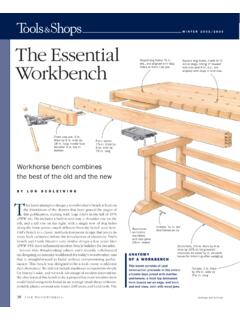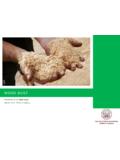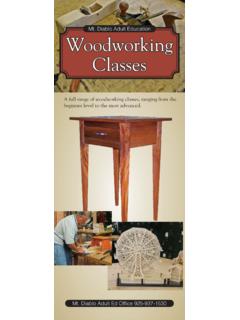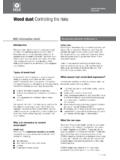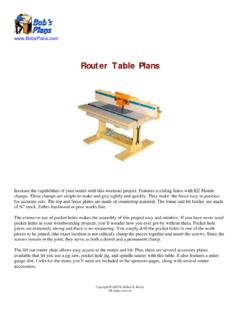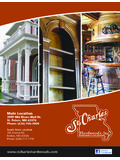Transcription of WOODWORKS: INTERMEDIATE PROJECT TRADITIONAL BOOKCASE
1 1 WOODWORKS: INTERMEDIATE PROJECT TRADITIONAL BOOKCASEHere s a PROJECT that s a lot easier than it may look and when completed provides a sturdy, great-looking place for your favorite books. It s simple to build because all the pieces are screwed together, and store-bought moldings artfully cover the screwheads. There areno dado or dowel joints. After studying the measured drawing, you can adjust the length, depth or height to suit your specific needs. You can also use adifferent wood besides the oak or pine recommended in this BOOKCASE gives INTERMEDIATE woodworking students the opportunity to learn a number of important, basic skills, including meas-uring, cutting, marking, drilling, gluing, clamping and mitering. And after you build the BOOKCASE , you ll learn how to apply stains andfinishes to protect the wood and keep it looking beautiful.
2 2 Hand tools Small crosscut saw Block plane Pipe or bar clamps at least 4 long Combination square Carpenter s square Screwdriver Nail setSHOPPING LISTTOOLS REQUIREDP ower tools Table or radial arm saw Router Belt sander Saber saw Electric drill Power screwdriver or screwdriver bits for drillMiscellaneous Pencil Carpenter s glue Safety glasses Utility knifeWOOD FINISHING PRODUCTS (Choose the recommended stain/finish or create your own combination)Recommended Finish Prep: Minwax Pre-Stain Water-Based Wood ConditionerStain: Minwax Water-Based Wood Stain Rosewood (or a Minwax Water-Based Custom Mixed Stain chosen from more than 60 colors)Finish: Minwax Polycrylic Protective Finish Semi-GlossAlternate FinishesMinwax Wood Conditioner (if using pine)Minwax Gel Stain Mahogany (or any of theseven other wood-tone colors)Minwax Fast-Drying PolyurethaneOr, a one-step finish: Minwax Polyshades Pecan (or any of the eight other wood-tone colors)MiscellaneousSandpaperGlovesClean , lint-free ragsMineral spirits (for oil-based finishes)Minwax Wood Putty Minwax Finishing BrushesWater-filled metal container with tight-fitting lidCONTINUED - WOODWORKS.
3 INTERMEDIATE PROJECT 2001-2002 TRADITIONAL BOOKCASECUTTING LISTA13/4 x 11-1/2 x 36 oak- or pine-veneer plywood (top)B23/4 x 11-3/8 x 27-1/4 oak- or pine-veneer plywood (sides)C33/4 x 11-1/8 x 34-1/2 oak- or pine-veneer plywood (top, bottom, shelf)D11/4 x 35-1/2 x 24-1/4 oak- or pine-veneer plywood (back)E13/4 x 3 x 37-1/2 oak or pine (base front)F23/4 x 3 x 12-1/4 oak or pine (base sides)G13/4 x 2 x 34-1/2 oak or pine (edging strips)H13/4 x 3/4 x 37-1/2 oak or pine (top front edging)J13/4 x 3/4 x 34-1/2 oak or pine (base cleat)K23/4 x 3/4 x 12-1/4 oak or pine (top side edging)ItemQuantity3/4 x 4 x 8 oak- or pine-veneer plywood1 x 4 x 4 oak- or pine-veneer plywood1 oak or pine lumber1 pc. 6 x48 , 1 pc. 4 x48 1/2 x 1/2 oak or pine cove molding12 ft.#6 x 2 drywall screws12#6 x 1-1/4 drywall screws201 brads401/4 brass shelf pins*4*Available at home centers and hardware stores or from Rockler Woodworking and Hardware, Dept.
4 HW, 4365 Willow Dr., Medina, MN 55340; (800) 279-4441. Stock # YOU BEGINGood craftsmanship begins and ends with good work habits, so makethe following steps part of your routine workshop practice. If you haveany doubts or questions about how to proceed with a PROJECT , alwaysdiscuss them with your shop instructor. Carefully and fully review plans and instructions before putting a toolto the PROJECT lumber. Work sensibly and safely. Wear safety goggles when doing work thatcreates flying chips and sawdust; wear the appropriate mask orrespirator whenever making sawdust or working with thinners orother solvents. At the end of every work session, clean up your shop area and putaway all portable AND ASSEMBLY PROCEDURER efer to the PROJECT illustration shown on page the 3/4 plywood pieces (A, B and C) to the sizes given in theCutting s Tips:Many people have trouble cutting hardwoodplywood cleanly, especially across the grain.
5 For this BOOKCASE ,you ll have to master this skill, because some of the cuts will showon the finished piece. Here are a few tricks: Be aware of which side of your plywood is the good side, andkeep it facing up while cutting on the table saw. Adjust your saw so the fence is exactly parallel to the blade, andthe miter gauge slots are exactly perpendicular to it. If not, theblade will tear up fibers where it touches the wood behind the cut. For the smoothest cuts, use a 10 carbide-tipped saw blade with60 to 100 teeth. If you re still not getting clean cuts, score the cutting line deeplywith a sharp utility knife before you the solid wood pieces (E, F, G, H, and K) a couple of incheslonger than the dimensions given, so they can be trimmed to exact size later. Part J can be cut to the specified size part G into 1/8 strips for gluing to the front edge of pieces Band C.
6 Your saw blade will be close to the fence, so use a push stick to guide the the strips (G) to the front edges of pieces B and C using yellowcarpenter s glue. After the glue is dry, cut or sand the strips so they reflush with the plywood. You can do this with a block plane or beltsander. If you use a sander, be careful not to cut or sand through thethin veneer of the plywood. If you ve never tried this operation before,you may want to experiment on some scrap plywood first. When thestrips are flush with the veneer, trim the ends with a small s Tip:Use strips of masking tape as clamps for theedge strips. Tape is strong enough for this job and less cumber-some than bar clamps. Apply a tape strip about every 3-4 . mitered ends on the 3/4 edging (H, K) that is used for the top(A). Cut the front piece (H) first, so that the miters are exactly flushwith the corners of the plywood, then cut the side pieces (K).
7 Clampthem to be sure they fit, then glue. The sides can be long in back andtrimmed after the glue is dry. When the glue has dried, sand the edgingflush with the the profile on the edge of the top with a router, using a 1/2 round-over bit with a pilot where the screws will go into the sides of the case, the top andthe cleats. Drill the countersinks, then the clearance holes for thescrews. Note that these holes are slightly off-center (about 1/16 ), sothe cove molding you add later will completely cover them. Woodworker s Tip:Drilling first and countersinking second canresult in a rough, chatter-marked hole, especially on oak plywood,which tears easily. Drill the countersink first, or use a combina-tion drill /countersink lay out and then drill the shelf pin holes into the inside faceof the sides (B).Woodworker s Tip:A common mistake is to drill the shelf-pinholes inaccurately, resulting in a shelf that wobbles because it snot sitting on all four corners.
8 To avoid this, mark out the holesvery carefully; use an awl to prick the surface where you want thedrill bit to start; and use a brad-point drill bit, which won t easilywander off the the rabbets on the back edges of the sides (B). The easiest wayto do this is with your table or radial arm saw, making two cuts andadjusting the fence after the first cut. Or, install a dado blade and set upthe saw to make the rabbets in one all the pieces you ve made so far. Start with 120-gritpaper and finish with s Tip:It s a good idea to do as much of your sand-ing as you can before any pieces are assembled. That way, youeliminate having to sand inside corners. The same goes for finish-ing: If you can finish parts separately and then assemble them, doit. Remember, however, that glue won t stick to a finished surface,so don t put finish on the surfaces of glue the pieces to be joined with screws and drill the pilotholes, using the countersunk clearance holes as your guide.
9 The BOOKCASE together. Start by screwing the top and bottomshelves (C) to the sides (B). Then screw the base cleat (J) to the bot-tom shelf (C). Next, screw the top (A) to the the base front piece (E) to the front of the BOOKCASE andmark on its inside surface where the miters should be cut. Cut thesemiters, then cut the miters on the base sides (F). Woodworker s Tip:Test your miter cuts on a couple of pieces ofscrap (plywood works fine) before making the final the three base pieces (E and F) fit well, cut the curved open-ing at the bottom of the base front (E). Give all the base pieces a finalsanding, then screw them onto the case. Use yellow carpenter s glue onthe miter joints and other surfaces that meet. Trim the ends of the sidepieces (F). the cove moldings for cutting the miter joints, and fit them onas you did with the edging and base pieces the front first and then thesides.
10 Drill pilot holes for the brads, not just into the cove molding, butinto the BOOKCASE as well. Nail on the molding, sink the nailheads 3 CONTINUED - WOODWORKS: INTERMEDIATE PROJECT 2001-2002 TRADITIONAL BOOKCASE slightly with a nail set, push putty into the nail holes. When the glue isdry, trim the ends of the molding and sand them the back (D) to size and sand it, but don t nail it on untilyou ve completed the prepare for finishing, slightly break all sharp edges on thebookcase with sandpaper. STAINING AND FINISHINGW oodworker s Tip:Though you may be tempted to cut shortyour sanding and wiping time, don t do it. Both of these tasks arevery important steps in obtaining a high-quality , it is the finish, just as much as the fit and smoothnessof the parts, that will have great bearing on how people judge yourcraftsmanship.



